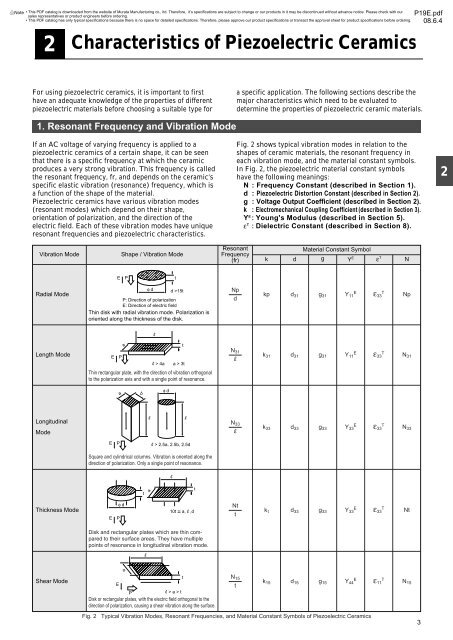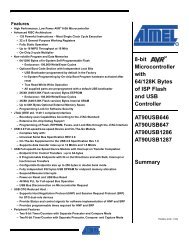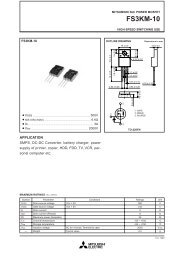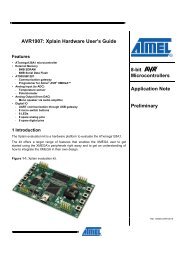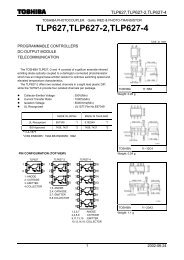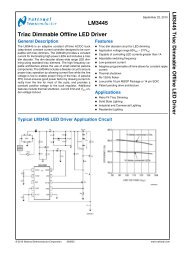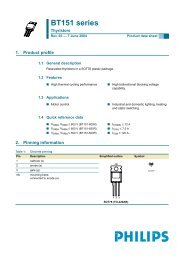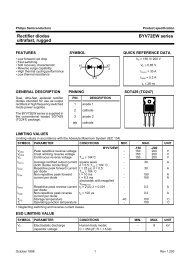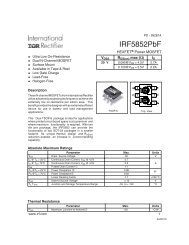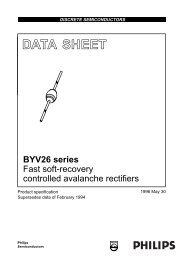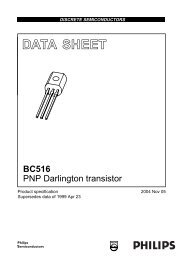Piezoelectric Ceramics ("PIEZOTITE") Sensors
Piezoelectric Ceramics ("PIEZOTITE") Sensors
Piezoelectric Ceramics ("PIEZOTITE") Sensors
You also want an ePaper? Increase the reach of your titles
YUMPU automatically turns print PDFs into web optimized ePapers that Google loves.
!Note • This !Note PDF catalog • Please is downloaded read rating and from !CAUTION the website (for of Murata storage, Manufacturing operating, rating, co., ltd. soldering, Therefore, mounting it’s specifications and handling) are in subject this catalog to change to prevent or our smoking products and/or in it may burning, be discontinued etc. without advance notice. Please check with our<br />
sales representatives • This catalog or product has only engineers typical specifications before ordering. because there is no space for detailed specifications. Therefore, please approve our product specifications or transact the approval sheet for product specifications before ordering.<br />
• This PDF catalog has only typical specifications because there is no space for detailed specifications. Therefore, please approve our product specifications or transact the approval sheet for product specifications before ordering.<br />
2<br />
Characteristics of <strong>Piezoelectric</strong> <strong>Ceramics</strong><br />
P19E.pdf<br />
08.6.4<br />
For using piezoelectric ceramics, it is important to first<br />
have an adequate knowledge of the properties of different<br />
piezoelectric materials before choosing a suitable type for<br />
a specific application. The following sections describe the<br />
major characteristics which need to be evaluated to<br />
determine the properties of piezoelectric ceramic materials.<br />
1. Resonant Frequency and Vibration Mode<br />
If an AC voltage of varying frequency is applied to a<br />
piezoelectric ceramics of a certain shape, it can be seen<br />
that there is a specific frequency at which the ceramic<br />
produces a very strong vibration. This frequency is called<br />
the resonant frequency, fr, and depends on the ceramic's<br />
specific elastic vibration (resonance) frequency, which is<br />
a function of the shape of the material.<br />
<strong>Piezoelectric</strong> ceramics have various vibration modes<br />
(resonant modes) which depend on their shape,<br />
orientation of polarization, and the direction of the<br />
electric field. Each of these vibration modes have unique<br />
resonant frequencies and piezoelectric characteristics.<br />
Fig. 2 shows typical vibration modes in relation to the<br />
shapes of ceramic materials, the resonant frequency in<br />
each vibration mode, and the material constant symbols.<br />
In Fig. 2, the piezoelectric material constant symbols<br />
have the following meanings:<br />
N : Frequency Constant (described in Section 1).<br />
d : <strong>Piezoelectric</strong> Distortion Constant (described in Section 2).<br />
g : Voltage Output Coefficient (described in Section 2).<br />
k : Electromechanical Coupling Coefficient (described in Section 3).<br />
Y E : Young's Modulus (described in Section 5).<br />
ε T : Dielectric Constant (described in Section 8).<br />
2<br />
Vibration Mode<br />
Shape / Vibration Mode<br />
Resonant<br />
Frequency<br />
(fr)<br />
Material Constant Symbol<br />
k d g Y E ε T N<br />
E<br />
P<br />
t<br />
Radial Mode<br />
φ d<br />
d >15t<br />
P: Direction of polarization<br />
E: Direction of electric field<br />
Thin disk with radial vibration mode. Polarization is<br />
oriented along the thickness of the disk.<br />
Np<br />
d<br />
kp<br />
d 31 g 31 Y 11<br />
E<br />
ε 33<br />
T<br />
Np<br />
R<br />
Length Mode<br />
E<br />
a<br />
P<br />
R> 4a<br />
t<br />
a > 3t<br />
N 31<br />
R<br />
k 31<br />
d 31 g 31 Y 11<br />
E<br />
ε 33<br />
T<br />
N 31<br />
Thin rectangular plate, with the direction of vibration orthogonal<br />
to the polarization axis and with a single point of resonance.<br />
a<br />
b<br />
φ d<br />
Longitudinal<br />
Mode<br />
R<br />
R<br />
N 33<br />
R<br />
k 33<br />
d 33 g 33 Y 33<br />
E<br />
ε 33<br />
T<br />
N 33<br />
E P<br />
R> 2.5a, 2.5b, 2.5d<br />
Square and cylindrical columns. Vibration is oriented along the<br />
direction of polarization. Only a single point of resonance.<br />
R<br />
t<br />
a<br />
t<br />
Thickness Mode<br />
E<br />
P<br />
φ d<br />
10t V a,R,d<br />
Nt<br />
t<br />
k t<br />
d 33 g 33 Y 33<br />
E<br />
ε 33<br />
T<br />
Nt<br />
Disk and rectangular plates which are thin compared<br />
to their surface areas. They have multiple<br />
points of resonance in longitudinal vibration mode.<br />
R<br />
a<br />
Shear Mode<br />
E<br />
P<br />
R> a > t<br />
Disk or rectangular plates, with the electric field orthogonal to the<br />
direction of polarization, causing a shear vibration along the surface.<br />
t<br />
k 15 d 15 g 15 Y 44<br />
E<br />
ε 11<br />
T<br />
N 15<br />
Fig. 2 Typical Vibration Modes, Resonant Frequencies, and Material Constant Symbols of <strong>Piezoelectric</strong> <strong>Ceramics</strong><br />
N 15<br />
t<br />
3


